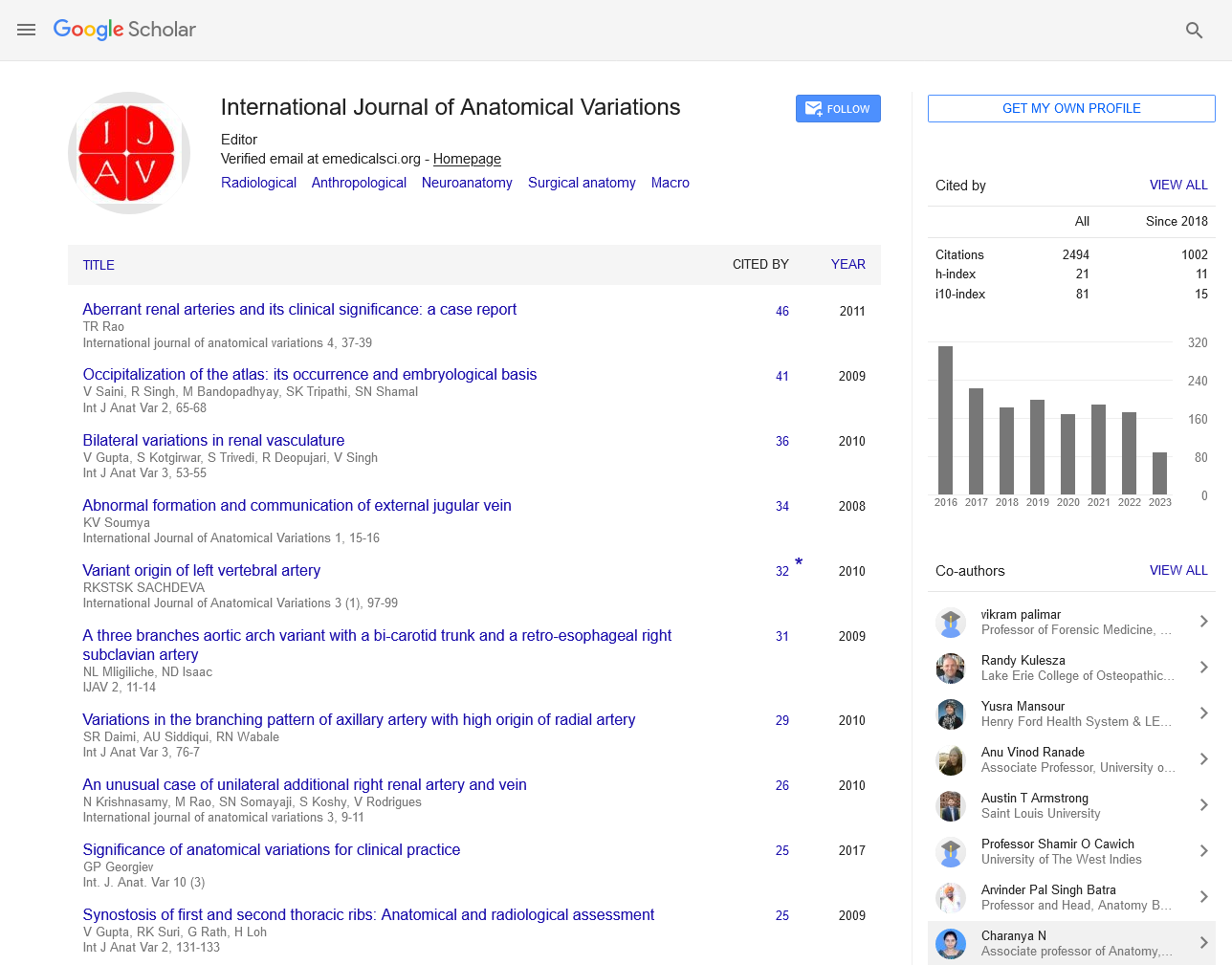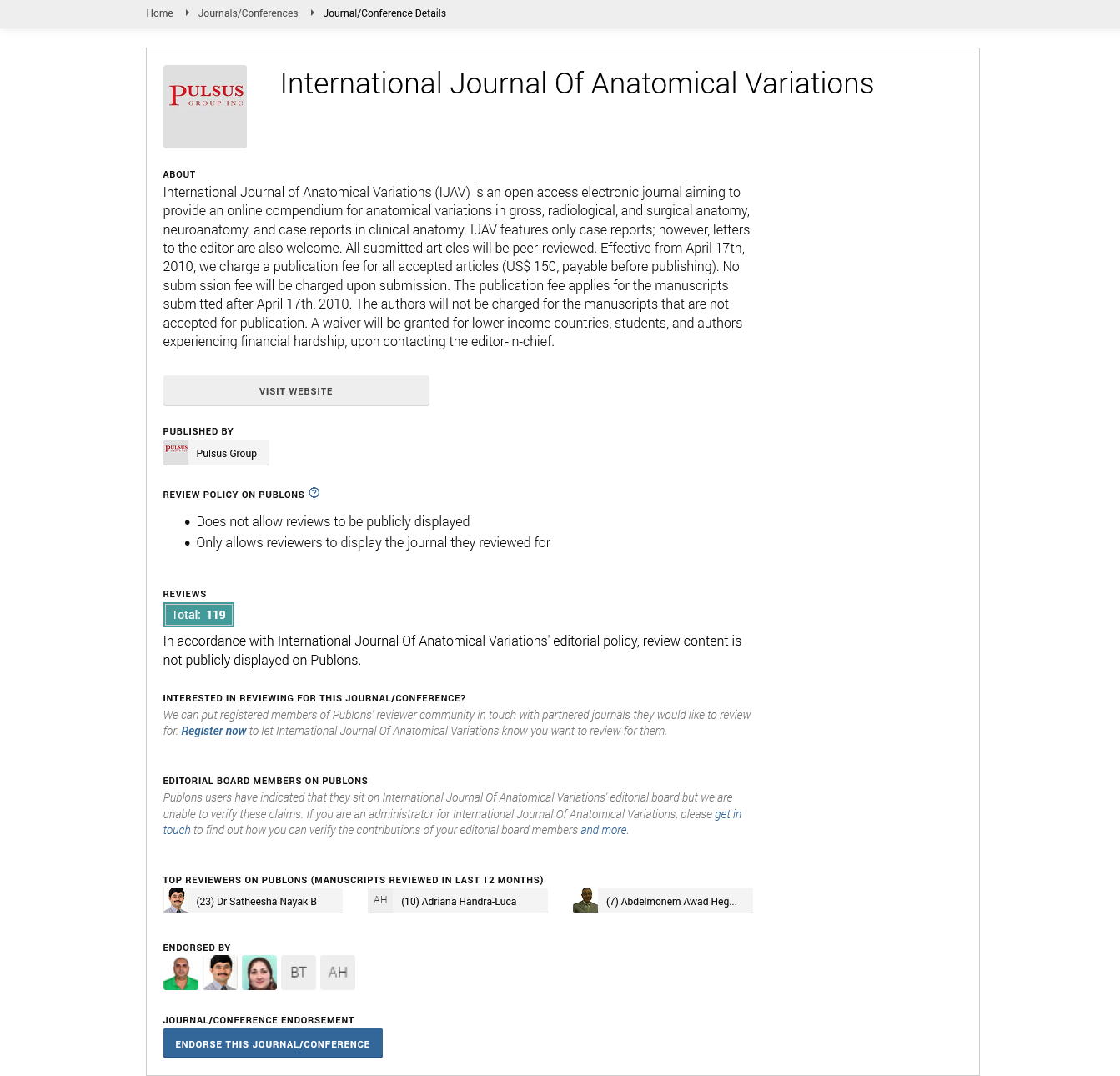Chondroid Ectopia in the Lungs: Pathological Anatomy and Its Relevance to Pulmonary Disorders
Received: 02-Jan-2025, Manuscript No. ijav-25-7547; Editor assigned: 04-Jan-2025, Pre QC No. ijav-25-7547 (PQ); Reviewed: 18-Jan-2025 QC No. ijav-25-7547; Revised: 24-Jan-2025, Manuscript No. ijav-25-7547 (R); Published: 31-Jan-2025, DOI: 10.37532/1308-4038.18(1).479
Citation: Hassan YAA. Chondroid Ectopia in the Lungs Pathological Anatomy and Its Relevance to Pulmonary Disorders. Int J Anat Var. 2025;18(1): 727-728.
This open-access article is distributed under the terms of the Creative Commons Attribution Non-Commercial License (CC BY-NC) (http://creativecommons.org/licenses/by-nc/4.0/), which permits reuse, distribution and reproduction of the article, provided that the original work is properly cited and the reuse is restricted to noncommercial purposes. For commercial reuse, contact reprints@pulsus.com
INTRODUCTION
The Chondroid ectopia in the lungs is a rare and intriguing pathological condition characterized by the presence of cartilage in areas where it is not typically found. The lungs, being primarily composed of soft tissue, rarely exhibit cartilaginous structures, making the occurrence of chondroid ectopia both a diagnostic and clinical challenge. This condition may arise from abnormal mesenchymal differentiation during embryogenesis or as a result of pathological processes such as chronic inflammation, tumors, or traumatic injury. Although it is often asymptomatic, chondroid ectopia can have significant clinical implications, especially when it presents in conjunction with pulmonary disorders such as bronchial obstruction, chronic cough, or hemoptysis. This article explores the pathological anatomy of chondroid ectopia in the lungs, its potential clinical manifestations, and its relevance to pulmonary disorders [1].
PATHOLOGICAL ANATOMY OF CHONDROID ECTOPIA
Chondroid ectopia is characterized by the abnormal presence of cartilage in the lungs, often found within the bronchi, bronchioles, or even within the alveolar structures, where cartilage is not usually present in normal lung anatomy. It can occur as a result of heterotopic cartilage formation, where cartilaginous tissue develops outside its typical location due to abnormal differentiation of mesenchymal cells. This phenomenon is most commonly seen in the large and medium-sized airways, where the cartilage may appear as nodular masses, plaques, or a diffuse infiltration of cartilage within the bronchial wall. Histologically, chondroid ectopia is defined by the presence of mature hyaline cartilage, which can vary in size and distribution within the lung tissue. The cartilage is often surrounded by fibrous tissue, and there may be an inflammatory infiltrate, particularly in cases where the ectopia is associated with chronic pulmonary conditions such as bronchiectasis, chronic obstructive pulmonary disease (COPD), or asthma. In some instances, chondroid ectopia may be observed as a part of a broader condition, such as a bronchial hamartoma, a benign tumor that contains a mix of tissues, including cartilage, smooth muscle, and glandular elements. The exact etiology of chondroid ectopia remains unclear, but it is believed to result from either developmental abnormality during embryogenesis or secondary changes linked to chronic inflammation and injury to the airway. In congenital cases, chondroid ectopia may be associated with other developmental anomalies, such as bronchial atresia or cystic malformations of the lungs. In acquired cases, it is often linked to long-standing pulmonary diseases, where chronic irritation and inflammation could stimulate the formation of cartilage within the bronchial walls [2].
CLINICAL MANIFESTATIONS OF CHONDROID ECTOPIA
In many cases, chondroid ectopia is asymptomatic and found incidentally during imaging studies for unrelated conditions. However, when symptoms do occur, they are often nonspecific and may include chronic cough, wheezing, dyspnea, or recurrent respiratory infections. The presence of cartilaginous tissue in the airways can lead to partial bronchial obstruction, which may cause airflow limitations and contribute to the development of obstructive pulmonary symptoms. Patients with chondroid ectopia in the context of chronic lung diseases such as asthma or COPD may experience exacerbations of their baseline symptoms. The cartilaginous masses or plaques may serve as a source of irritation, contributing to the narrowing of the bronchial lumen and, in turn, precipitating episodes of wheezing, coughing, or shortness of breath. Additionally, if the ectopic cartilage is located near major airways or blood vessels, it may cause hemoptysis due to damage to the airway walls or small blood vessels. In some instances, chondroid ectopia may coexist with bronchial tumors, such as bronchial hamartomas, leading to more pronounced symptoms. These tumors can sometimes grow large enough to cause significant obstruction of the airway, resulting in more severe respiratory distress, post-obstructive pneumonia, or recurrent episodes of respiratory infections [3].
DIAGNOSTIC APPROACHES TO CHONDROID ECTOPIA
The diagnosis of chondroid ectopia often relies on imaging studies, particularly high-resolution computed tomography (CT) scans of the chest. These scans can reveal areas of increased density within the lung parenchyma or bronchial walls, which may correspond to the presence of ectopic cartilage. On CT imaging, chondroid ectopia typically appears as focal or diffuse areas of calcification or cartilage within the bronchial walls, which may or may not be associated with airway narrowing or obstruction. Bronchoscopy may also be used as a diagnostic tool, particularly when the ectopia is located within the larger airways. During bronchoscopy, direct visualization of the bronchial tree can reveal unusual structures, such as nodular masses or irregularities in the bronchial lining, which may suggest the presence of cartilage. Biopsy of the affected area may be necessary to confirm the diagnosis, as histological examination can demonstrate the characteristic cartilage and fibrous tissue. In cases where chondroid ectopia is suspected to be associated with other pulmonary disorders, such as bronchiectasis, recurrent infections, or tumors, additional imaging studies such as positron emission tomography (PET) scans or magnetic resonance imaging (MRI) may be used to assess the extent of the disease and the involvement of other structures [4].
RELEVANCE TO PULMONARY DISORDERS
Chondroid ectopia has significant relevance in the context of pulmonary disorders, especially when it coexists with or contributes to preexisting conditions. In patients with chronic pulmonary diseases, the formation of ectopic cartilage can exacerbate airway obstruction and impair normal lung function. The cartilaginous masses within the bronchi can act as mechanical barriers to airflow, leading to symptoms such as wheezing, coughing, and difficulty breathing. These symptoms can be particularly challenging to manage in individuals already affected by conditions like asthma or COPD, as the additional presence of cartilage may further compromise the respiratory function. Moreover, chondroid ectopia may complicate the management of bronchial tumors, such as hamartomas, which are benign but can present with symptoms similar to those of malignancies. The differentiation between a benign cartilaginous mass and a malignant tumor is essential for determining the appropriate treatment approach. In some cases, surgical resection may be necessary, particularly when the ectopic cartilage leads to significant airway obstruction or is associated with recurrent infections.
The presence of chondroid ectopia can also be a source of concern in cases of hemoptysis, where the cartilaginous tissue may cause damage to blood vessels in the bronchial walls. This can lead to bleeding and require urgent intervention. It is essential for clinicians to consider the possibility of chondroid ectopia in differential diagnoses when assessing patients with unexplained hemoptysis or chronic respiratory symptoms [5].
TREATMENT AND MANAGEMENT
Management of chondroid ectopia typically depends on the severity of symptoms and the underlying pulmonary condition. In many cases, when the ectopia is asymptomatic or mildly symptomatic, no specific treatment is required. Patients may simply be monitored through regular follow-up imaging to assess any changes in the size or structure of the ectopic cartilage. For symptomatic cases, treatment strategies may focus on managing the associated pulmonary disorder. In patients with chronic cough, wheezing, or obstructive symptoms, bronchodilators or corticosteroids may help alleviate airway inflammation and improve airflow. If there is significant bronchial obstruction or recurrent infections, surgical intervention may be necessary to remove the ectopic cartilage or the underlying tumor, such as a bronchial hamartoma, contributing to the symptoms. In severe cases of hemoptysis or when significant airway compromise occurs, more aggressive surgical or interventional approaches, such as bronchoscopy or resection, may be required to remove the source of bleeding and restore normal airway function.
CONCLUSION
Chondroid ectopia in the lungs is a rare but important pathological condition that can complicate various pulmonary disorders. The presence of ectopic cartilage in the bronchial walls can contribute to airway obstruction, recurrent infections, and hemoptysis, especially when it coexists with chronic pulmonary diseases such as asthma or COPD. While often asymptomatic, the condition can become clinically relevant in patients experiencing respiratory symptoms or in those with associated bronchial tumors. Early diagnosis through imaging and bronchoscopy, along with appropriate management strategies, is essential for minimizing complications and improving patient outcomes. Understanding the pathological anatomy of chondroid ectopia is crucial for clinicians in providing accurate diagnoses and effective treatment plans.
REFERENCES
- Mamikonyan VR, Pivin EA, Krakhmaleva DA. Mechanisms of corneal neovascularization and modern options for its suppression. Vestn Oftalmo. 2016; 132(4):81-87.
- Gaigalaite V, Dementaviciene J, Vilimas A, Kalibatiene D. Association between the posterior part of the circle of Willis and vertebral artery hypoplasia. PLoS ONE. 2019; 14(9): e0213-226.
- Anri S, Masayoshi O, Shigeru H. Glomerular Neovascularization in Nondiabetic Renal Allograft Is Associated with Calcineurin Inhibitor Toxicity. Nephron. 2020; 144 Suppl 1:37-42.
- Mujagic S, Kozic D, Huseinagic H, Smajlovic D. Symmetry, asymmetry and hypoplasia of intracranial internal carotid artery on magnetic resonance angiography. Acta Med Acad. 2016; 45:1- 9.
- Rusu MC, Vrapclu AD, Lazar M. A rare variant of accessory cerebral artery. Surg Radiol Anat. 2023; 45(5):523-526.
Indexed at, Google Scholar, Crossref
Indexed at, Google Scholar, Crossref
Indexed at, Google Scholar, Crossref
Indexed at, Google Scholar, Crossref






